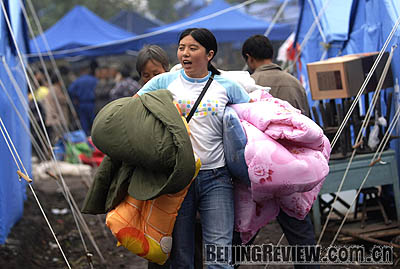|

Getting the mountains of earthquake relief supplies from the point of arrival at Shuangliu Airport, a major distribution hub for domestic and international aid provision in Chengdu, capital of quake-hit Sichuan Province, to the far reaches of the devastated countryside is no mean feat. It is a systematic process that requires a huge amount of coordination all pushed along by the desperate need of victims. Here we look at the various procedures at distribution points and relief centers in the province.
Shuangliu Airport
When the day's first relief supplies arrived at Shuangliu Airport at 8 a.m. on May 24, Li Haiying, an official with the Civil Affairs Department of Sichuan, checked each delivery order. He told attending media that without a designated consignee or without specific indication where the material should go, the civil affairs authorities would take charge of aid and dispatch it accordingly.
The cargo received that morning was mainly food and as Guangyuan City was in dire need of food, that's where the goods were sent.
At about 10 a.m., after the license plate number, the loaded cargo and the cargo destination were registered, He Jinchun, a private driver, got his vehicle dispatch card. Only with such a card in hand could he leave the cargo center with the relief supplies. In Guangyuan, the relief worker who received the goods would sign a name or stamp on the dispatch card, proving that the cargo had arrived.
Although the quality and weight of the food were already on the delivery card, when the cargo was loaded onto the truck, these details were checked again and the figures were also written on the dispatch card.
At 11 a.m., after volunteers helped to load all the cargo, Li gave He the recipient's telephone number. Before the truck moved out of the cargo center, gate guards checked the dispatch card for the last time and then He headed out to Guangyuan.
Chengdu North Railway Station
Apart from Shuangliu Airport, the other main distribution hub for emergency aid in Chengdu is the Chengdu North Railway Station. The Sichuan Provincial Red Cross Society, the Chengdu Municipal Civil Affairs Bureau and the Chengdu Municipal Bureau of Commerce have jointly set up an office at the railway station. Volunteers here follow a strict working procedure involving cargo receiving, checking and dispatching, with each link of the process having a designated person to take charge.
Fenghuangshan Airport
When the relief supplies are transported to Fenghuangshan Airport in the suburb of Chengdu from Shuangliu Airport or Chengdu North Railway Station, helicopters transport the cargo to "isolated" places where roads are blocked by rocks and mudslides or to counties under the jurisdiction of Aba Tibetan-Qiang Autonomous Prefecture.
A large amount of medicine and about 30 tons of mineral water, milk, instant noodles and tents are stored here in six big warehouses every day. Officials from Sichuan Provincial Government, mainly health and civil affairs departments, take the responsibility to monitor this process.
After local officials itemize and pack relief supplies into the warehouses, the supplies then fall under military jurisdiction. When the relief supplies are delivered to an outlying quake-hit area, the pilot flying the supplies out must have the principal in charge of local affairs sign his or her name on the delivery order.
An official with the Civil Affairs Department of Sichuan told the media that while government workers are mainly engaged in the receiving and dispatching of relief supplies, the military's responsibility is to safeguard and transport the supplies.
Mianyang City
A donation center has been established here, comprising several teams in charge of receiving, planning, distribution coordination and transportation.
Mass donations are firstly categorized and then distributed on demand. Workers at the center also help individual donors ferry their donations directly to those in need, because there is a shortage of cargo trucks. No matter how the relief supplies are sent to quake-hit areas, the cargo must be registered and relief workers must report to the local earthquake relief and rescue headquarters on arrival.
Anxian County
Relief supplies are distributed by the county authority. According to relief workers here, some townships might ask for more goods than they actually need, so the aid distribution is based on analysis of the overall situation in these quake-stricken townships, such as the number of affected people and the degree of damage. Township officials sign for all goods dispatched and received.
| 